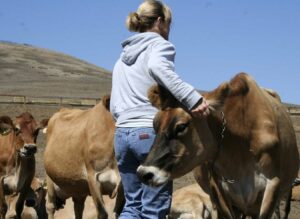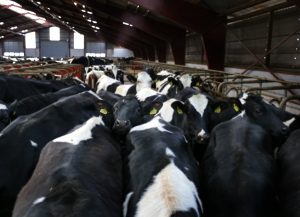Alvaro Garcia
The transition period is challenging for lactating dairy cows. Many ailments pop-up of metabolic as well as infectious origin result of increased stress/reduced defenses, and sudden increased body demands for nutrients. One frequent problem in high producing, over conditioned cows is ketosis. According to US dairy producers, ketosis is the top metabolic problem in dairy cows (APHIS, 2014).
It occurs in cows in early lactation and concurrent with feed intake depression. As a result, a negative energy balance follows worsened by the high glucose demand milk synthesis. The body responds by mobilizing fat which results in high blood serum concentrations of non-esterified fatty acids (NEFAs), later metabolized in the liver to ketone bodies (acetone, acetoacetate, and β-hydroxybutyrate; BHB). Two types of ketosis are currently recognized. Type I, occurs at peak milk production and results from this negative energy balance; Type II, occurs immediately after calving and is the result of fatty liver.
A recent article published in the J. Dairy Sci (Sahar et al., 2020) evaluated hyperketonemia in five commercial dairies. A total of 80 multiparous Holstein cows in their close-up period were selected from these farms based on their previous postpartum health. Cameras set five meters above the feeding area recorded feeding and agonistic interactions during the first 90 minutes after fresh feed delivery at the feed bunk. Behavioral aspects observed were latency to enter the feed bunk, time spent at the feed bunk, time spent in the cow feed alley while waiting to access feed, and the number of agonistic interactions. Twice a week and for two weeks after calving blood samples were obtained from the coccygeal vessels to measure BHB.
The average time spent eating during the 90 minutes after offering fresh feed decreased as cows approached calving. The drop in time eating was greater in cows that later developed hyperketonemia. Healthy cows post calving tended to spend more time in the feed alley and spend more time eating. For each additional 15 minutes eating, cows had 1.3 times higher chance of remaining healthy.
Concerning the agonistic behaviors, cows that remained healthy had more agonistic interactions compared to those that developed hyperketonemia. For every six additional interactions with other cows, they had 1.9 times higher odds of remaining healthy post-calving. The researchers chose the first 90 minutes after fresh feed delivery based on a previous study which showed that competitive interactions and feed bunk attendance peaked during the 90 minutes post fresh feed delivery. This shortened period of observation appears to still be useful for identifying animals at risk, resulting in a more efficient approach to monitoring. Since it would not be practical for farmers to record individual cow feeding and agonistic behaviors for 90 minutes, the authors suggested some type of automatic data collection (e.g., automatic feed bins or computerized approaches).
Cows that become sick postpartum had engaged in fewer agonistic interactions prepartum. This is explained since sick cows tend to avoid social interaction. The odds of remaining healthy almost doubled for every 6-unit increase in prepartum interactions. The researchers also examined separately the effects on the “actor” cow (the one displacing another at the feed bunk) with the “reactor” cow (the one being displaced). Reactor cows tended to be less likely to remain healthy, but the frequency of reactor behaviors was not associated with the disease outcome.
The authors concluded that cows who spend less time eating during the first 90 minutes after fresh feed delivery prepartum are at increased risk of developing ketosis postpartum. They also found that cows who spent more time in the feed alley had higher possibilities of not developing ketosis. Cows at risk of ketosis were more often the ones displaced from the feed bunk.
Prepartum feeding and agonistic behavior can be used to predict animals at risk of developing ketosis postpartum. Cows spending 88 of the 90 minutes eating had an 87% chance of avoiding ketosis postpartum. Conversely, cows that did not eat during the observation period had an 89% chance of becoming sick. Since healthy cows tended to spend more time in the cow feed alley pre calving, it seems plausible that this measure could be used as a practical predictive approach for the development of ketosis in the transition period.
Reference
Sahar, M. W., Beaver, A., Weary, D. M., von Keyserlingk, M. A. 2020. Feeding behavior and agonistic interactions at the feed bunk are associated with hyperketonemia and metritis diagnosis in dairy cattle. Journal of Dairy Science. 103: 783-790.
© 2020 Dairy Knowledge Center, LLC. All Rights Reserved.











